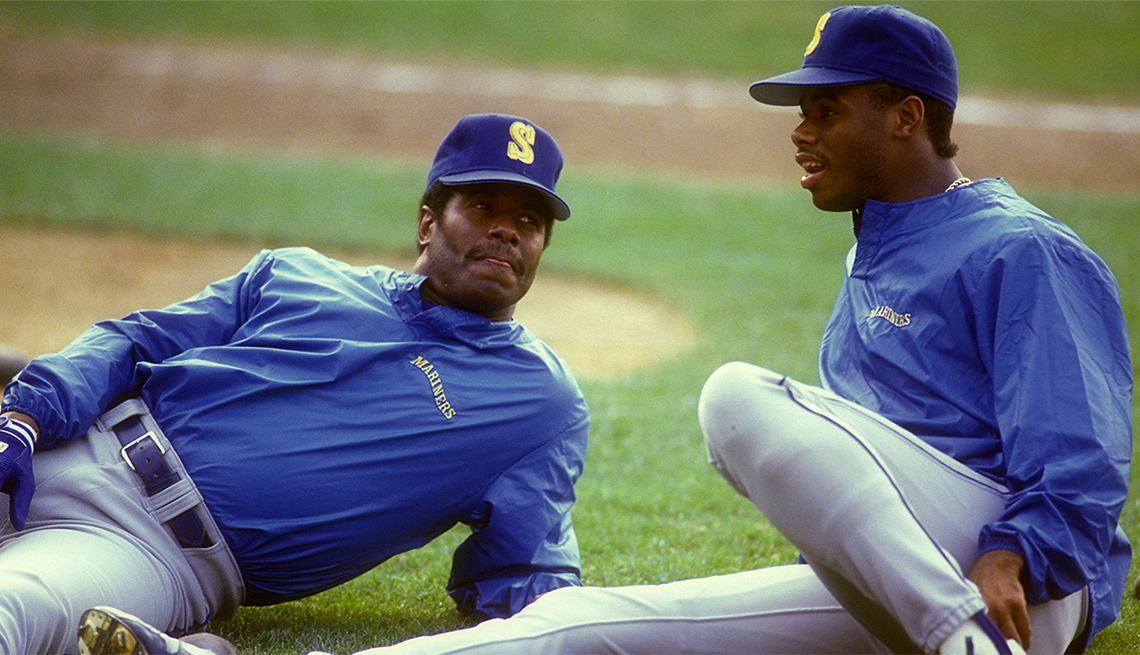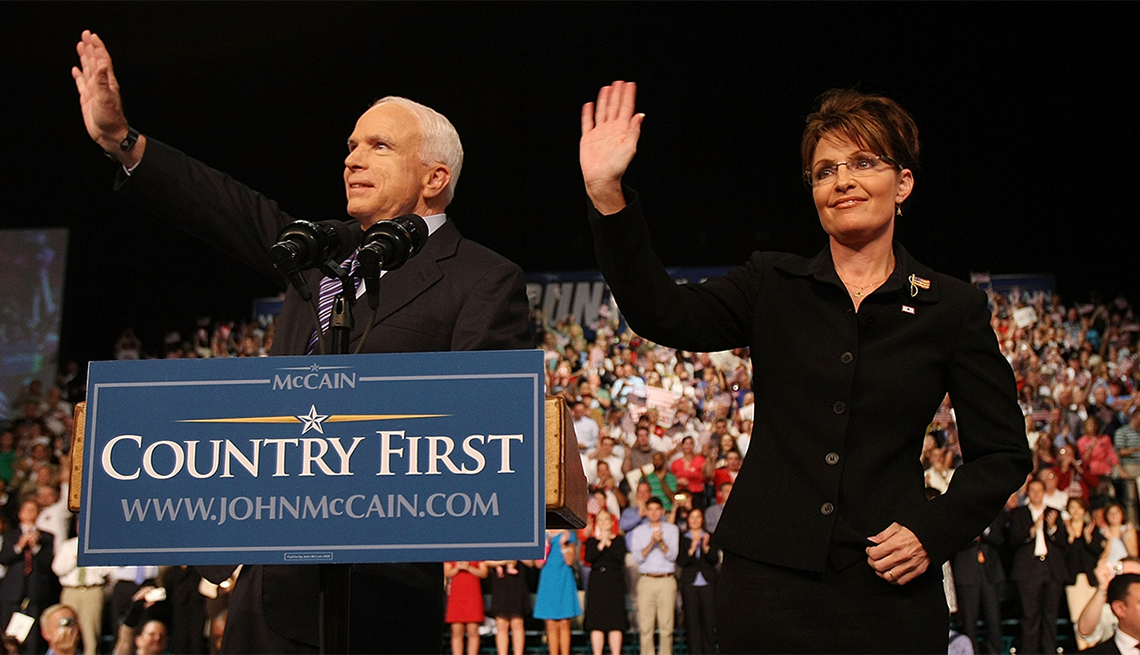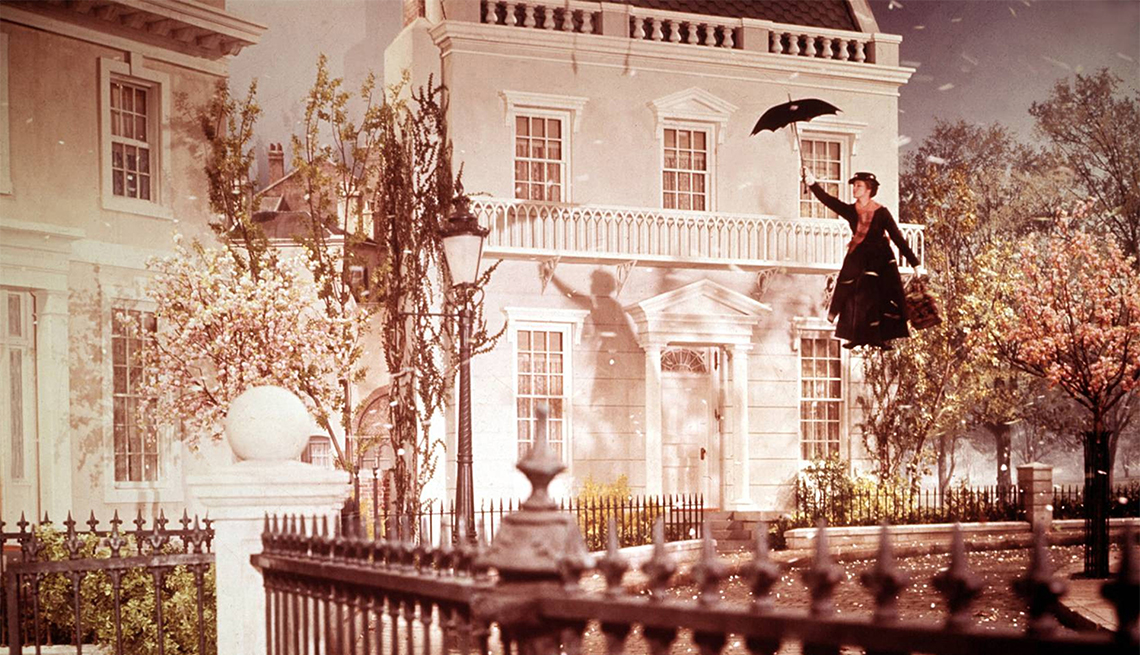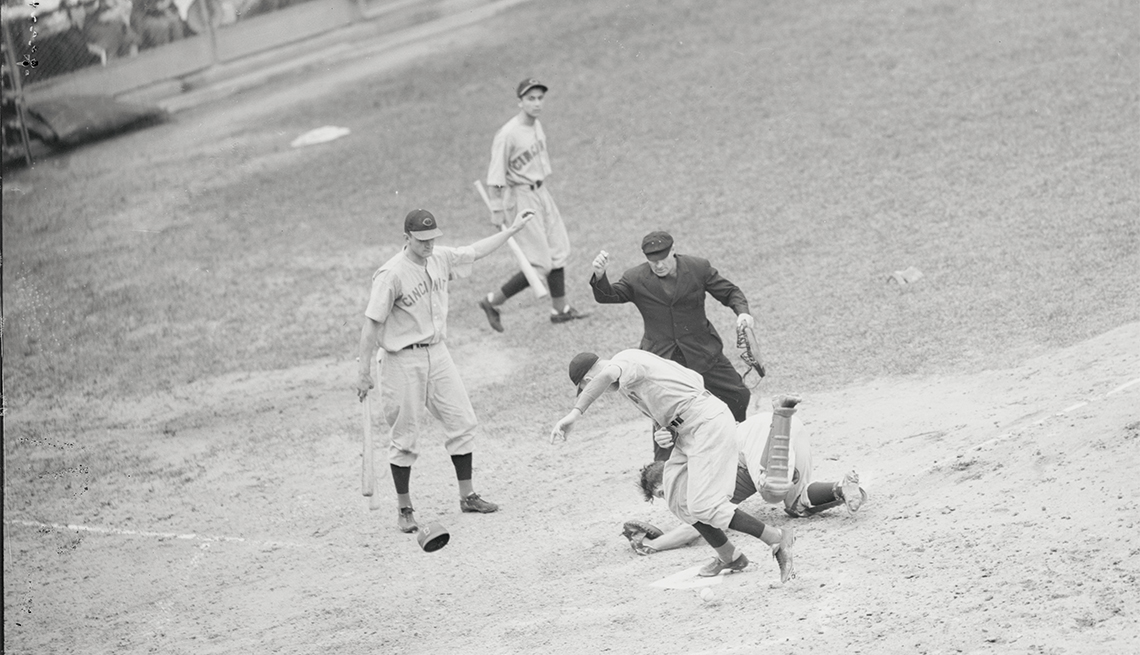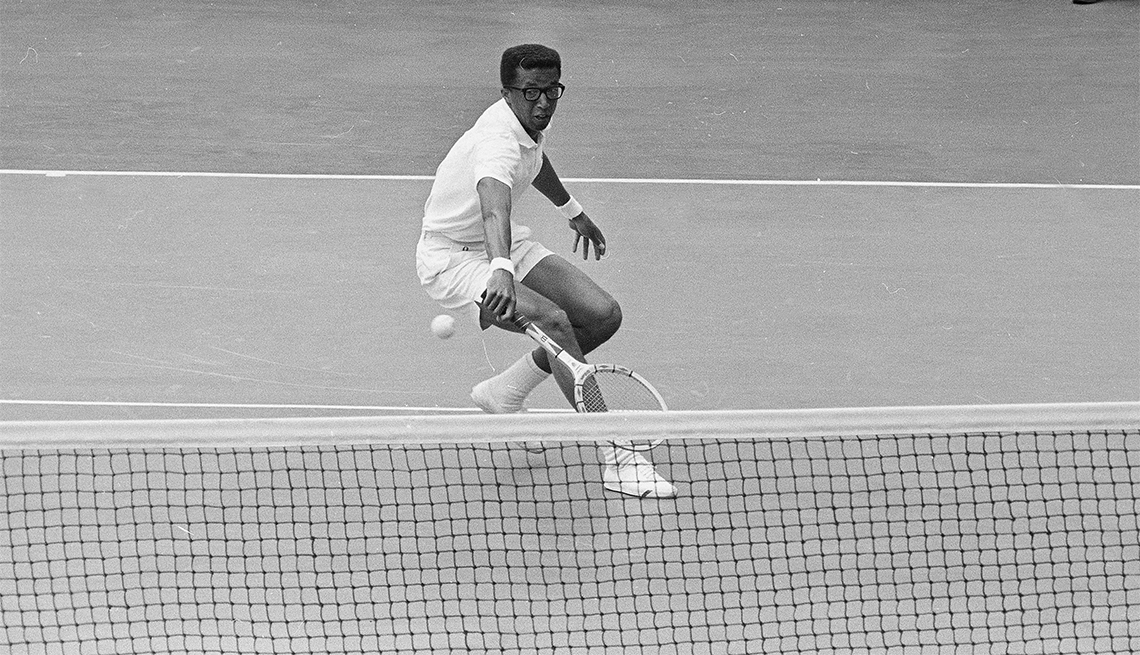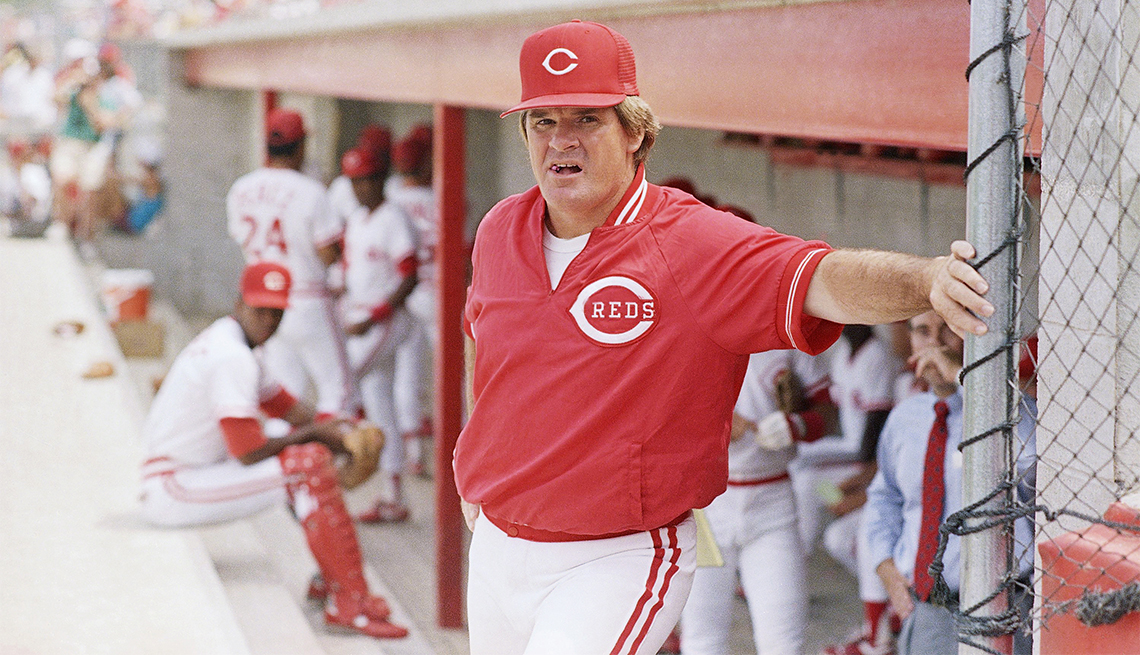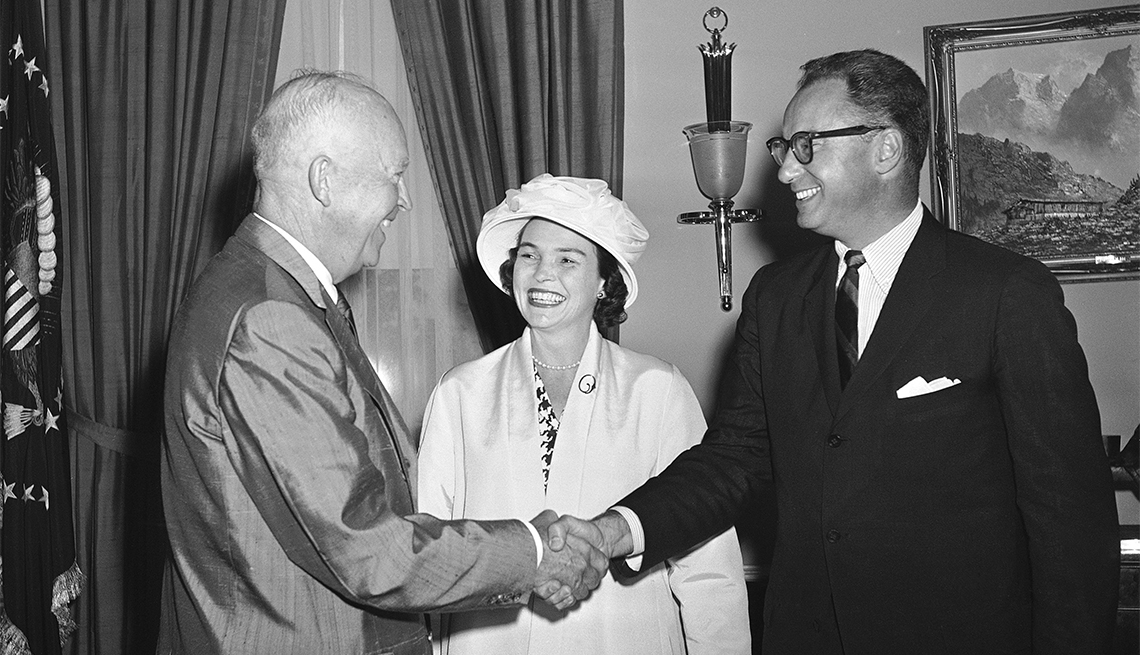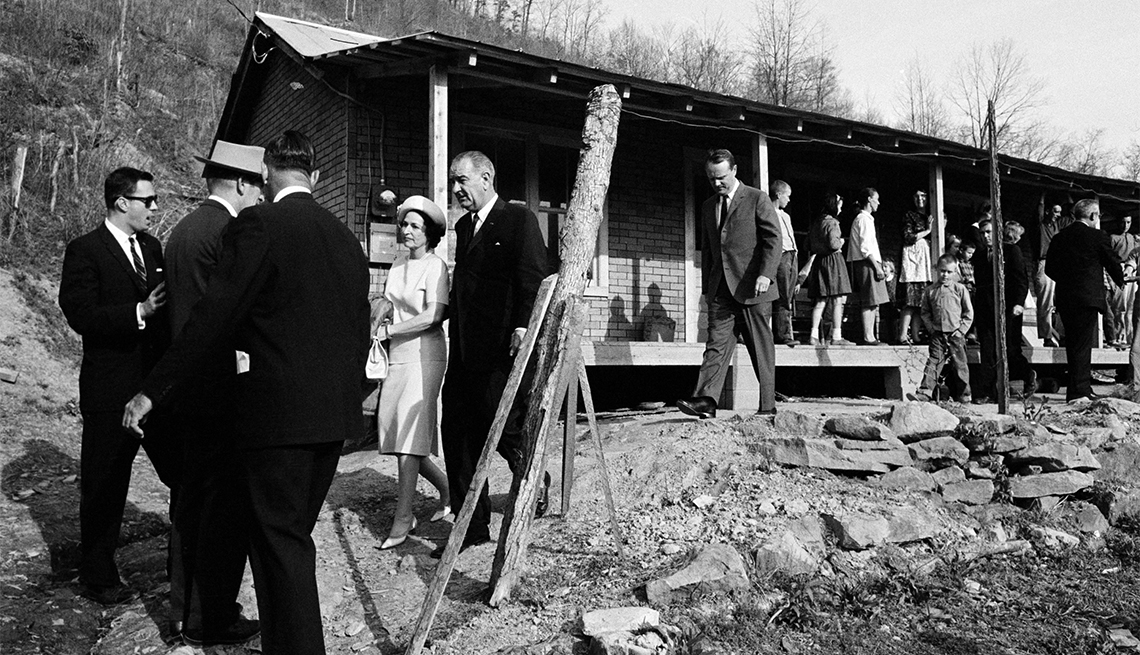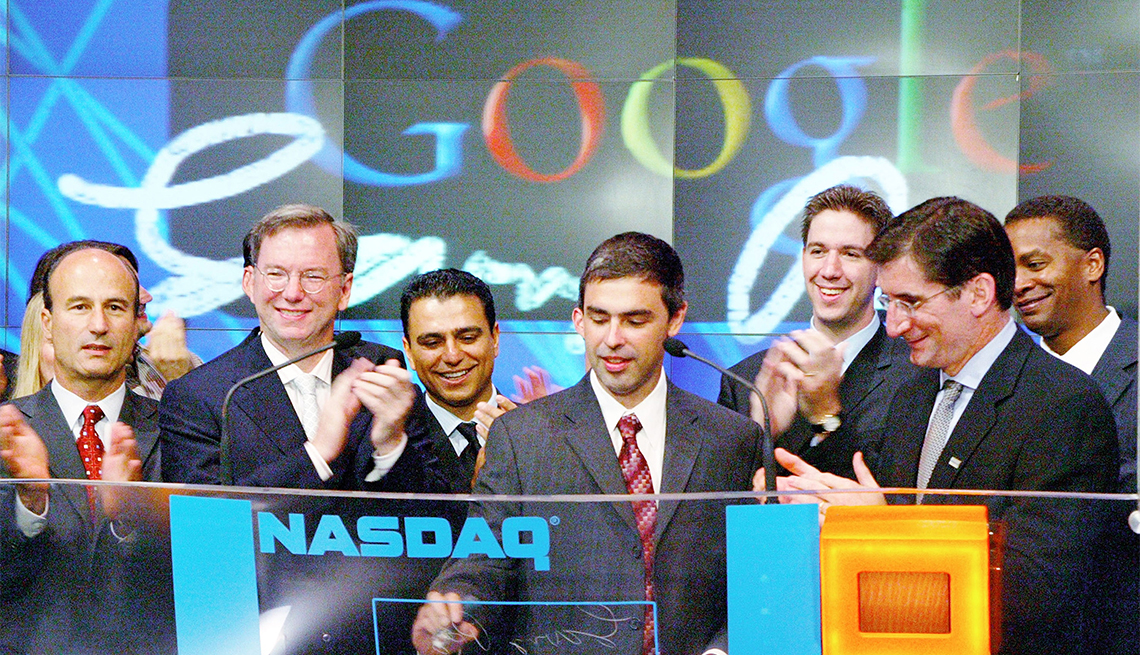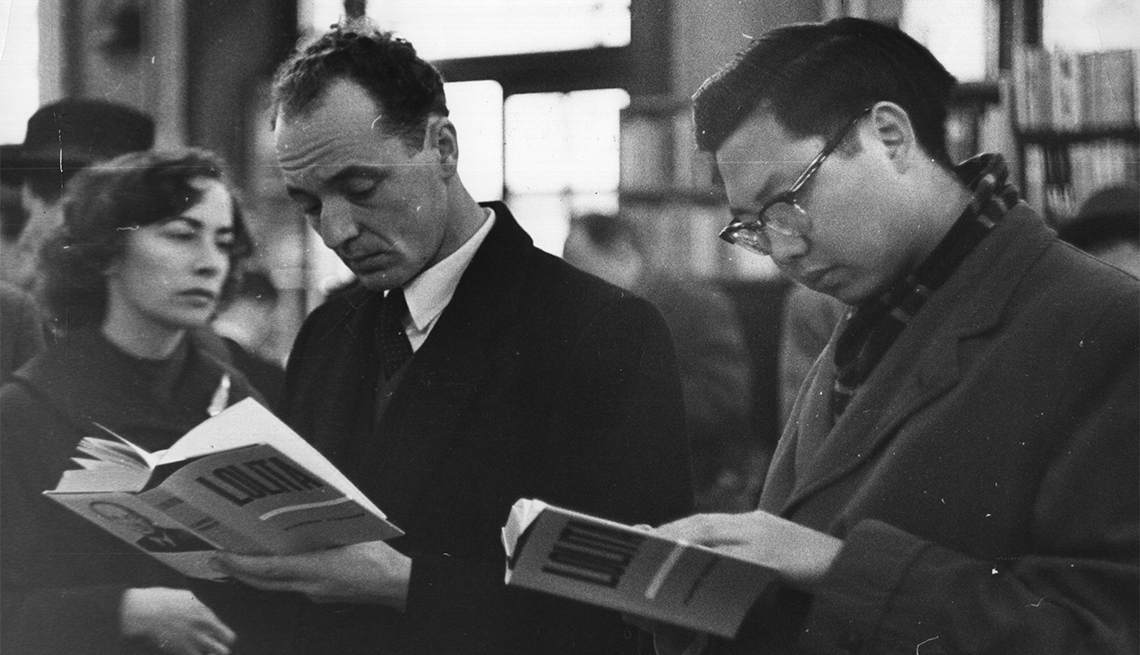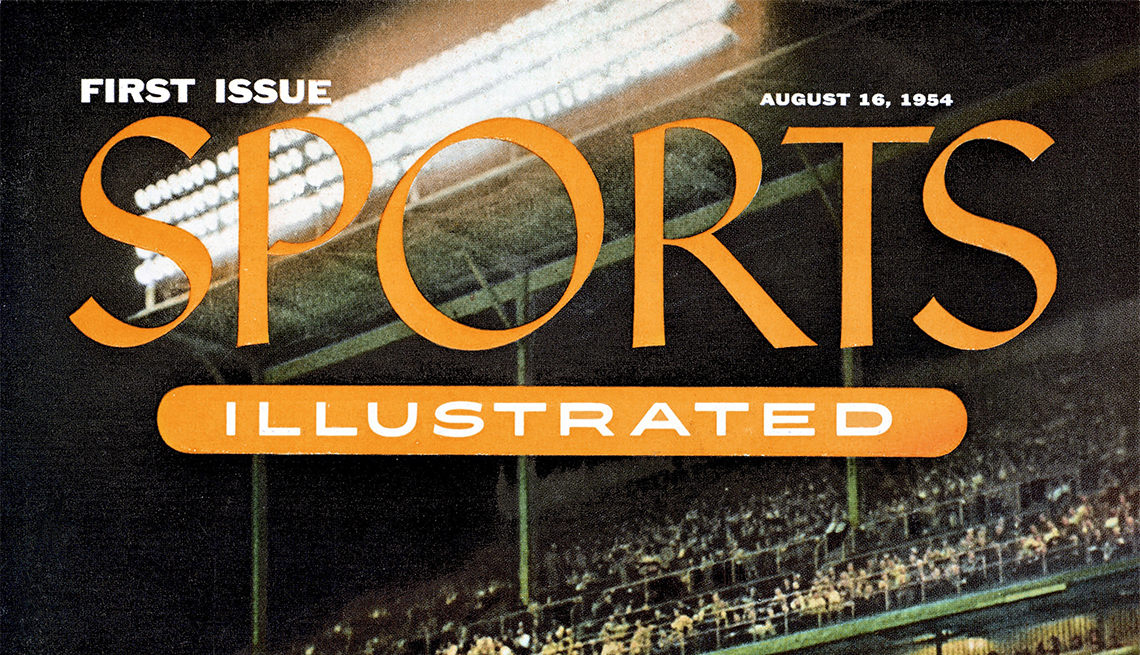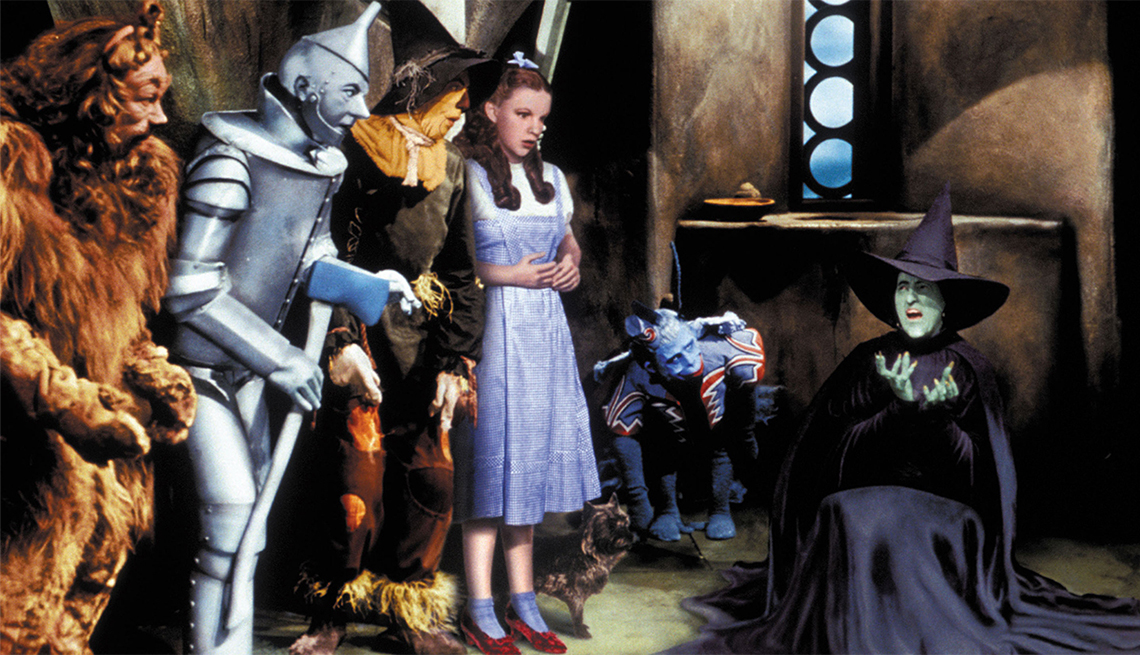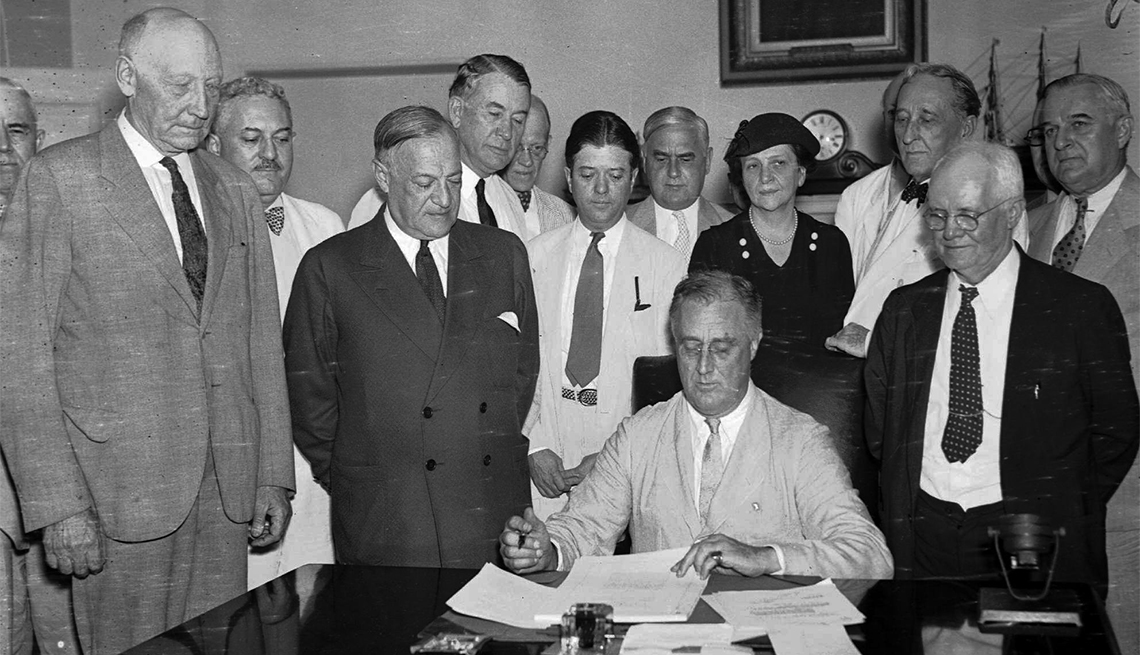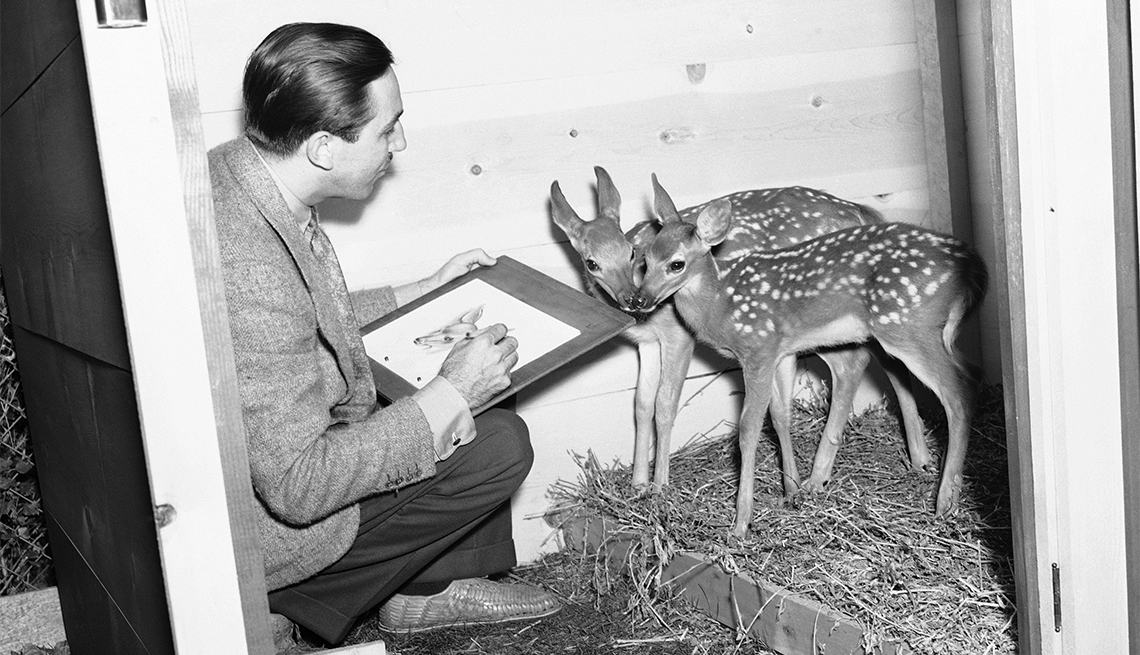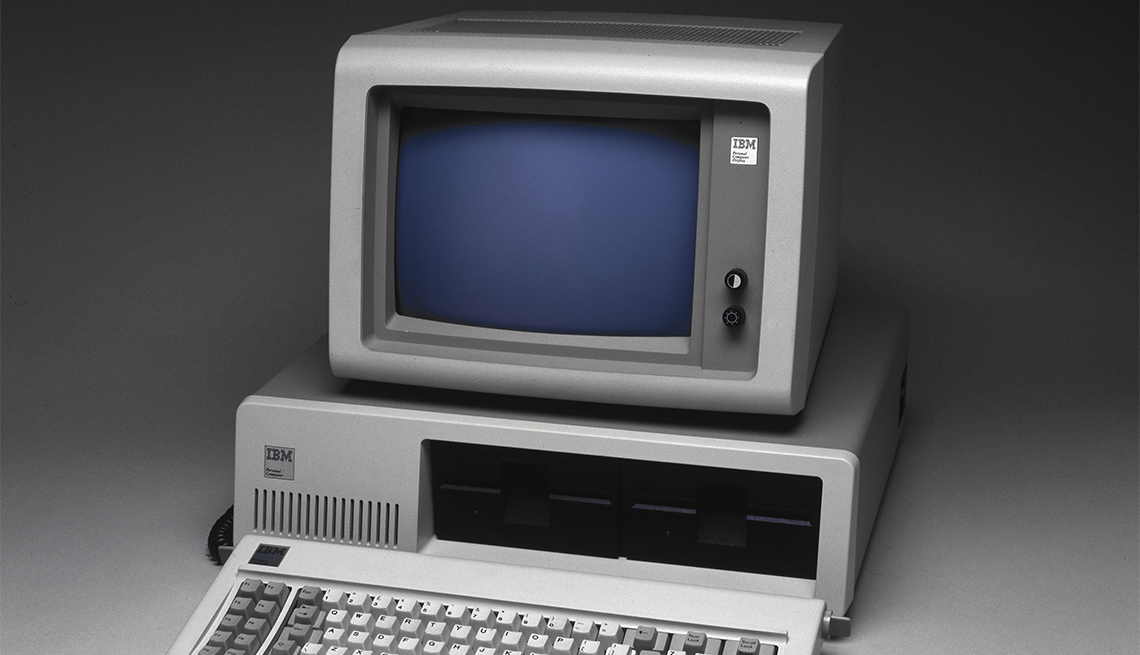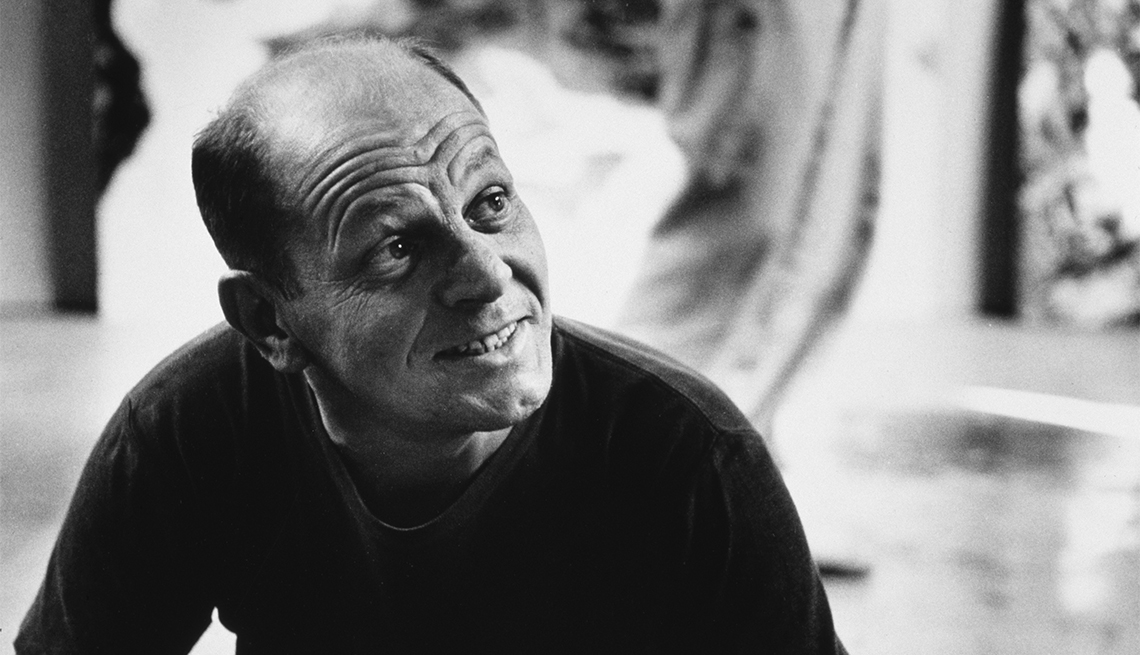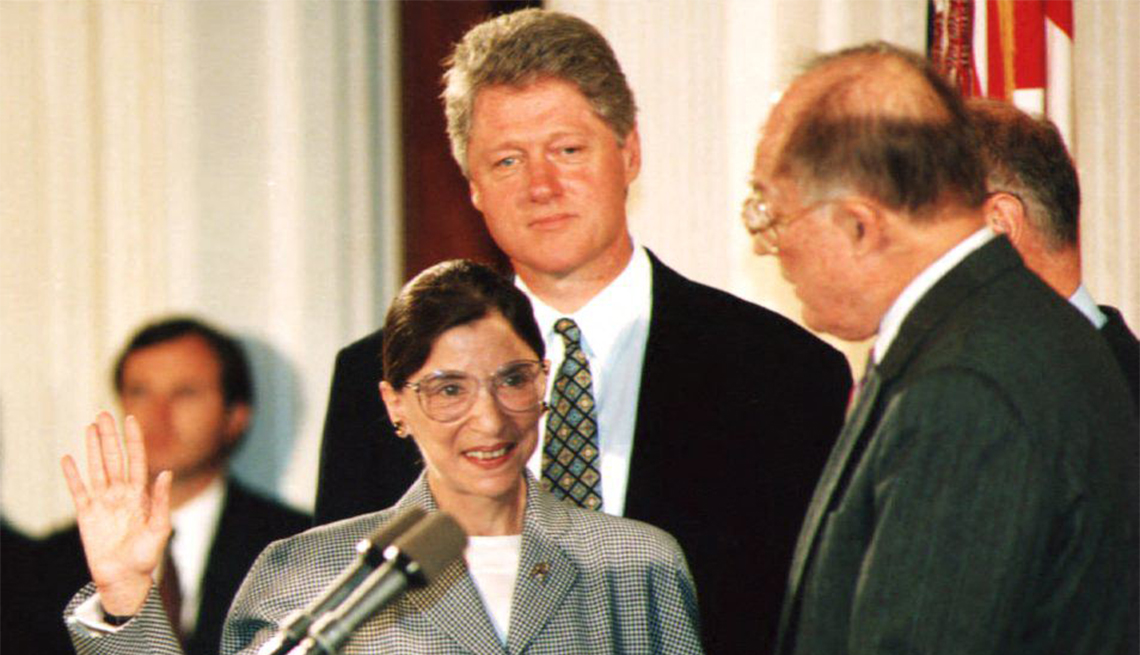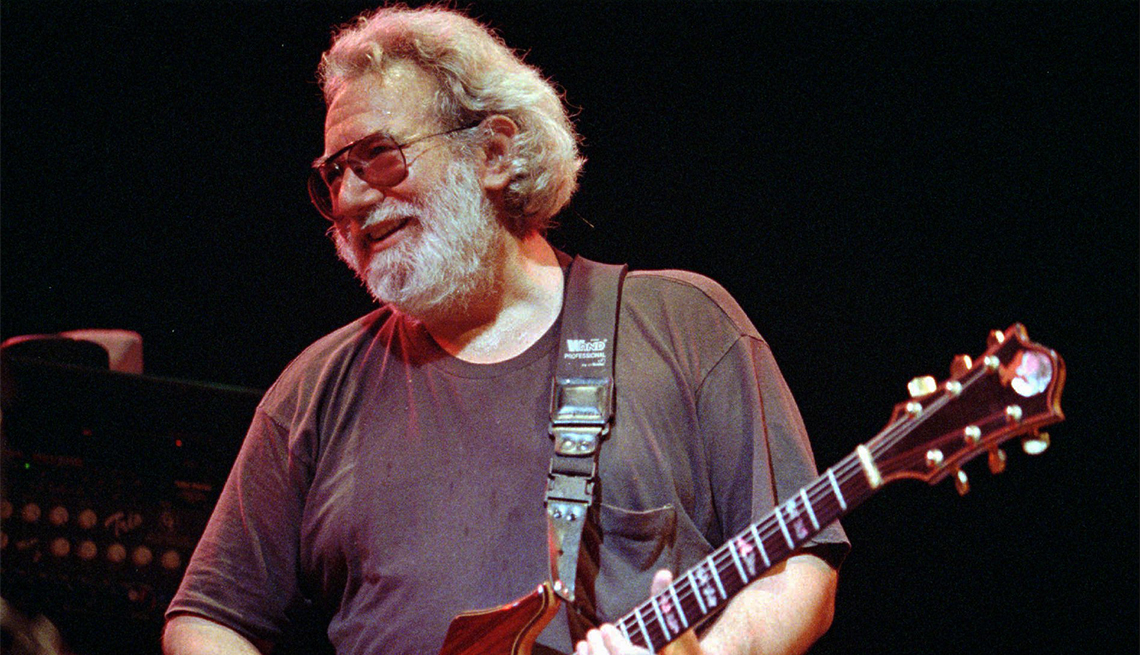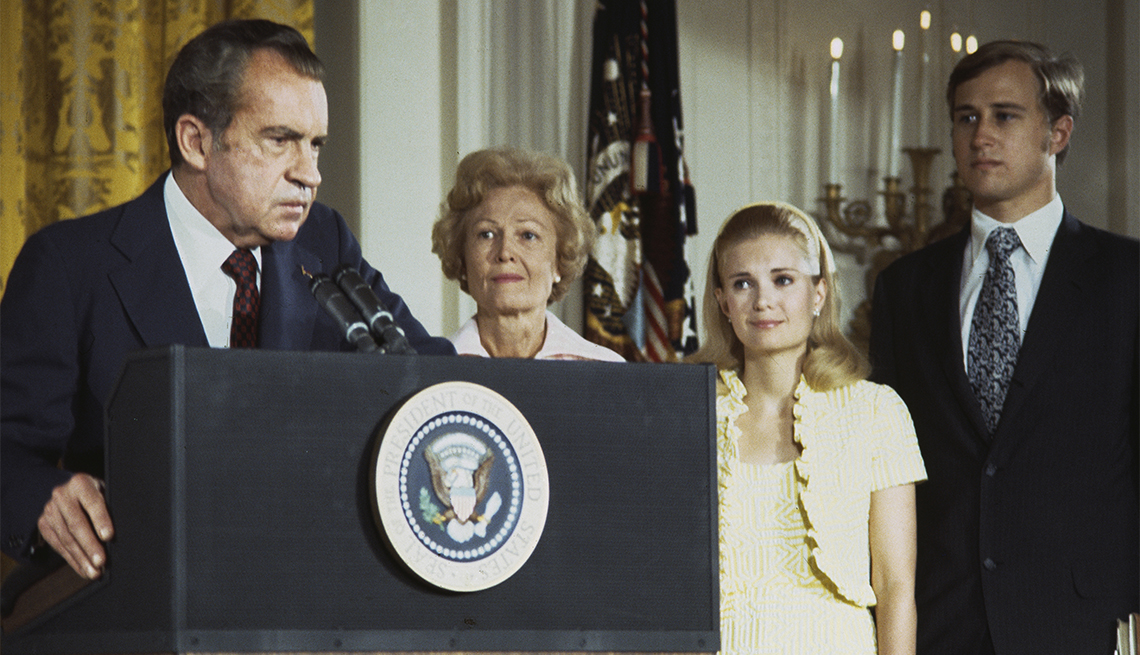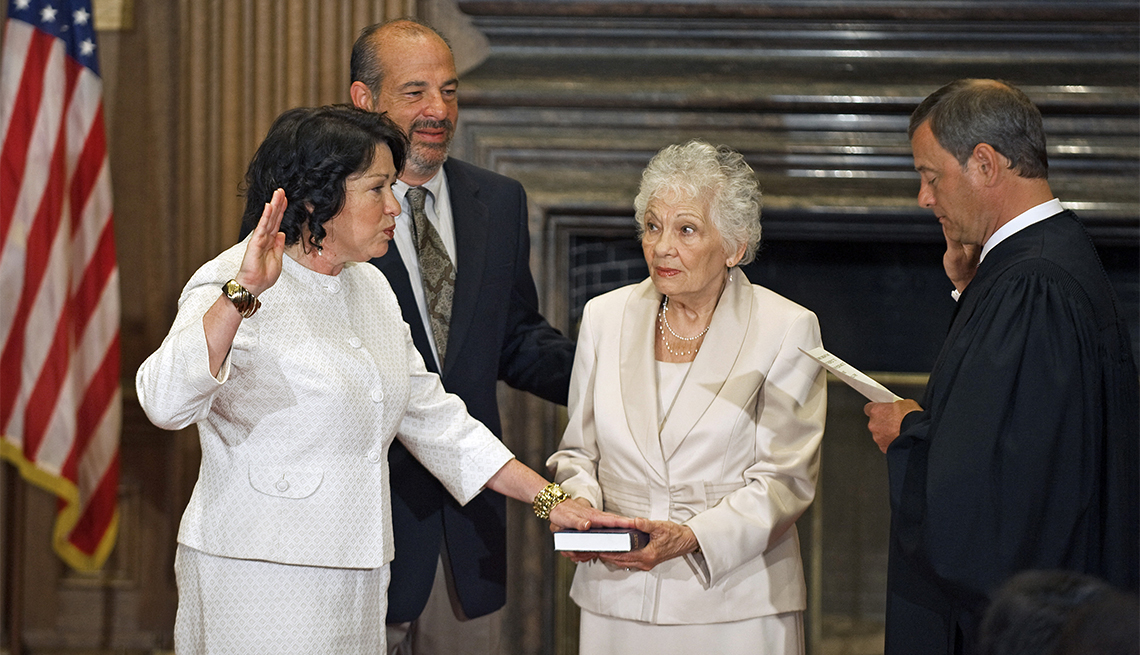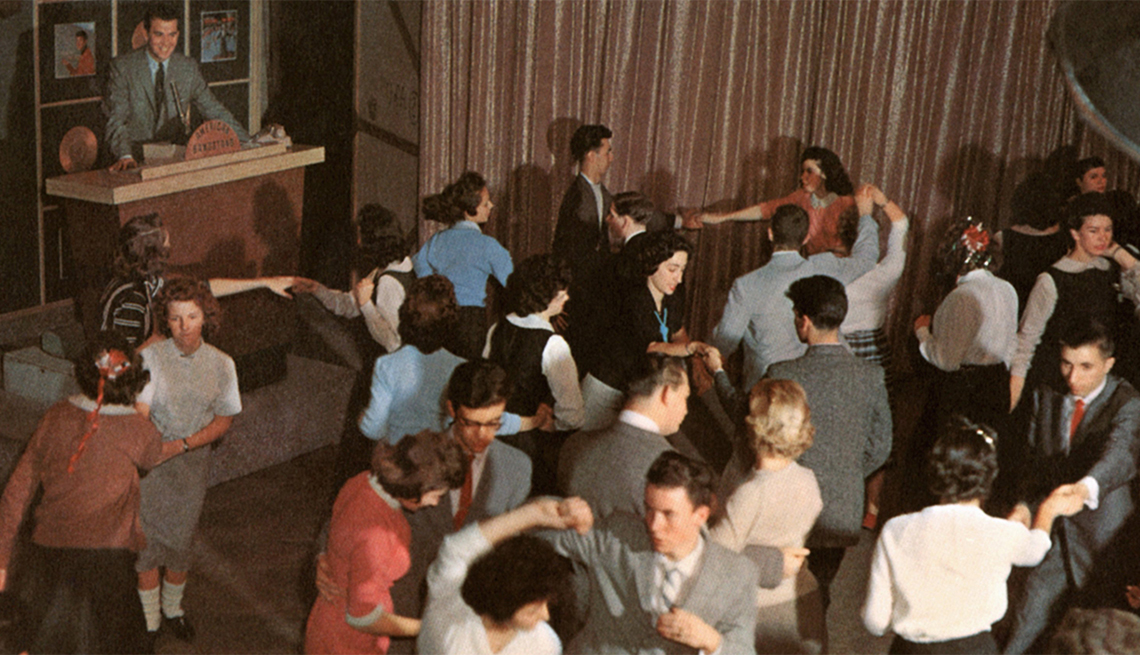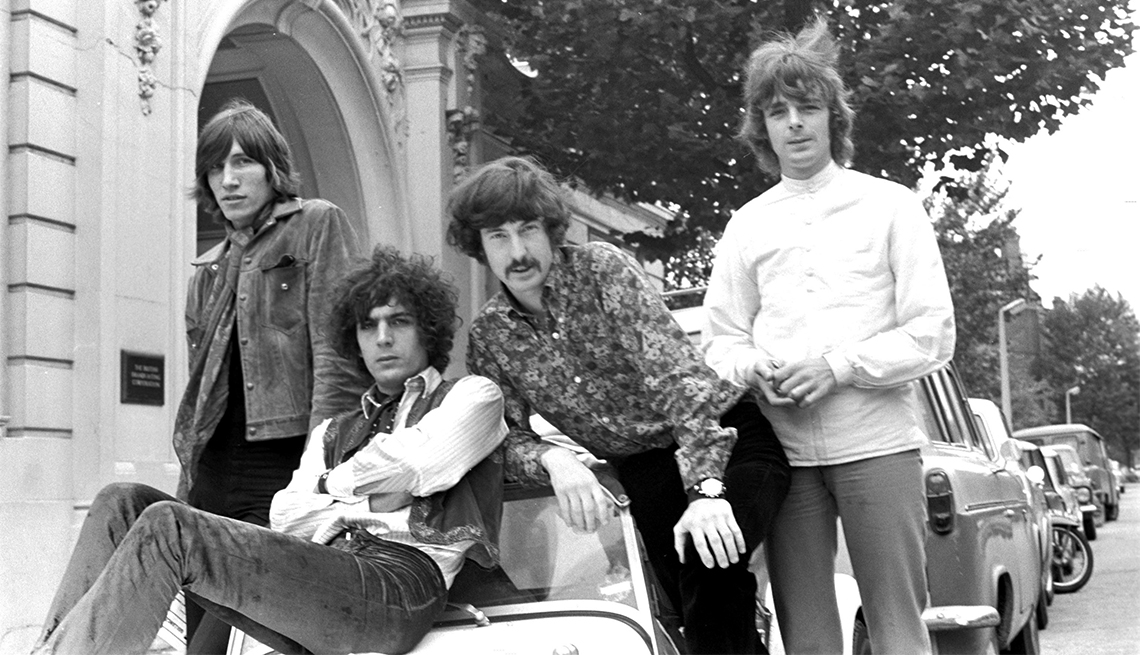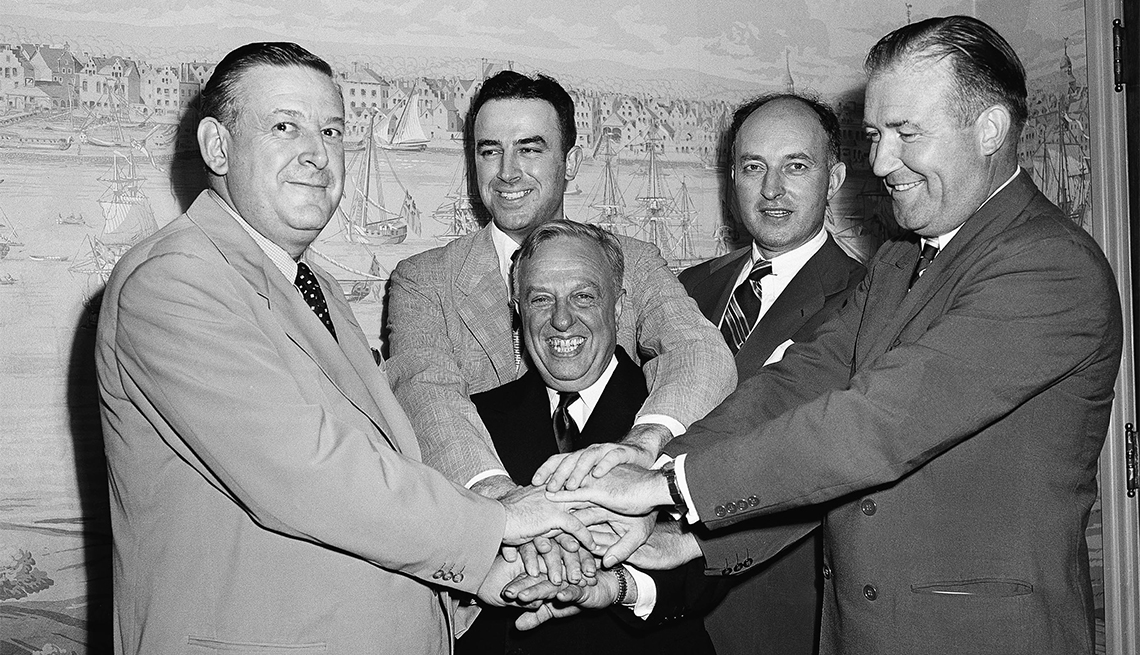August’s Today in Your History
A look at the events that shaped our lives, including President Nixon’s resignation and the first televised MLB games
AARP, August 2023
- |
- Photos
-
- 1 of
PHOTO BY: Mitchell Layton/Getty Images
Aug. 31: Ken Griffey Sr. and Ken Griffey Jr. become the first father-son duo to play on the same MLB team (1990)
On this date in 1990, the Griffey family — 40-year-old Ken Sr. (left field) and 20-year-old Ken Jr. (center field) — made MLB history when they became the first father-son duo to play a professional baseball game together. They both played for the Seattle Mariners in their debut home game against the Kansas City Royals, each going 1-for-4, and the elder Griffey won a bet against his son when he landed the first hit. Later, when the veteran player threw out Bo Jackson at second base, he received a standing ovation from the crowd. “Being a father, I guess it’s a dream come true,” Griffey Sr. told The Washington Post. “This is the pinnacle — this is the thing in my career that I’m very proud of.” The game proved to be emotional for both generations, with Jr. saying after the game: “I wanted to cry or something. It just seemed like a father-son game, like we were out playing catch in the backyard. But we were actually playing a real game. The weird thing was all the guys are yelling, ‘Let’s go, Ken,’ and I’m yelling, ‘Let’s go, Dad.’” —Nicholas DeRenzo
-
- 2 of
PHOTO BY: Dave Einsel/Getty Images
Aug. 30: Flooding intensifies in New Orleans a day after Hurricane Katrina makes landfall (2005)
One of the most devastating natural disasters in recent American history, Hurricane Katrina made landfall in Mississippi and Louisiana on August 29 with winds maxing out around 170 miles per hour and a storm surge up to 26 feet. Though New Orleans wasn’t in the line of a direct hit, the city underwent devastating damage that day and the next, as continued heavy rainfall pummeled the area and the storm surge filled the lakes surrounding the city and breached the levees. In low-lying areas like the 9th Ward, many residents sought shelter on their rooftops and were rescued by helicopter. Elsewhere, the Louisiana Superdome provided refuge for 30,000, while 25,000 more evacuated to the Convention Center. During the worst of it, about 80 percent of the Big Easy was flooded, reaching depths of up to 20 feet. When the waters finally cleared, the Gulf Coast region faced more than $160 billion in damage, making it the costliest natural disaster in the nation’s history, and an estimated 1,800 people lost their lives. —Nicholas DeRenzo
-
- 3 of
PHOTO BY: Mario Tama/Getty Images
Aug. 29: Senator John McCain names Governor Sarah Palin as his running mate (2008)
During the 2008 presidential election cycle, Senator John McCain earned a reputation as somebody willing to work across the aisle, which sometimes rankled the conservative base of the Republican Party. In an effort to appeal to those voters, his search for a running mate caused him to look in some unexpected places, and on this date in 2008, he announced his selection: Alaska Governor Sarah Palin, a 44-year-old “hockey mom” known for her folksiness and her position far outside the D.C. establishment. In his announcement at a rally in Dayton, Ohio, McCain called Palin “the running mate who can best help me shake up Washington,” and said of the much-younger politician, “She’s got grit, integrity, good sense and fierce devotion to the common good that is exactly what we need in Washington today.” When the political neophyte took to the stage, she detailed her rise from PTA mom to city council member and then mayor and governor. While her story was inspiring to some, Palin had a penchant for flubs, and the calculated risk didn’t quite pay off for the Arizona veteran and former prisoner of war: Barack Obama and Joe Biden won the election that November with a commanding 365 electoral votes and 52.9% of the popular vote. —Nicholas DeRenzo
-
- 4 of
PHOTO BY: Jeff Kravitz/Getty Images
Aug. 28: Beyoncé reveals her pregnancy during the MTV Video Music Awards (2011)
It’s been 12 years since Beyoncé took to the black carpet of the 2011 MTV Video Music Awards in a red Lanvin gown and surprised the preshow audience when she seemed to announce that she was pregnant: Queen Bey pulled the flowing fabric taut over her body, all but confirming that she and Jay-Z were expecting when she cradled her barely noticeable baby bump. Later, dressed in a shimmering Dolce & Gabbana blazer, she appeared onstage to perform “Love on Top” and started by announcing, “I want you to feel the love that’s growing inside of me.” When she was done, she unbuttoned the jacket and caressed her stomach, as Jay-Z looked on proudly from the audience. The costuming coup wasn’t without its hiccups, according to Beyoncé’s mother, Tina Knowles-Lawson, who had helped design her performance looks for years, going back to the Destiny’s Child days. Two hours before the VMAs, Knowles-Lawson said, Bey’s team realized that her custom pants weren’t stretchy enough, and she found herself shopping for maternity clothes at A Pea in the Pod and sewing the panels into her daughter’s costume. “When she opened that jacket and showed her stomach it was the biggest relief ever,” she wrote in an Instagram caption. “We didn’t have to keep the secret anymore. I didn’t have to design with the first priority being to camouflage the growing belly! … It was the best feeling in the world to [see] her show the whole world that tummy.” Beyoncé’s daughter, Blue Ivy Carter, was born the following January and today performs with her mother. —Nicholas DeRenzo
-
- 5 of
PHOTO BY: Donaldson Collection/Getty Images
Aug. 27: Mary Poppins has its world premiere in Los Angeles (1964)
Mary Poppins, Walt Disney’s magical adaptation of the P.L. Travers book, swept into cinemas on this date in 1964, when it premiered at Grauman’s Chinese Theater in Hollywood. Advertised as a “most unusual world premiere,” the opening festivities were broadcast live on local Los Angeles television and over the radio. It was the first Disney gala premiere since Snow White and the Seven Dwarfs in 1937. Joining the cast on the red carpet were Disney and Travers themselves plus a slew of major Hollywood celebrities, including the cast of The Dick Van Dyke Show, alongside less-expected attendees, such as human-sized dancing penguins and mascot characters from Disneyland. The film’s seamless blending of animation and live action and its soundtrack of eminently hummable tunes made it an instant fan and critical favorite: It was nominated for 13 Academy Awards, taking home five trophies, including best actress for Julie Andrews and best song for “Chim Chim Cher-ee.” Mary Poppins finished out the year as the top-grossing movie of 1964, beating out My Fair Lady, which must have felt like a vindication for Andrews. She had been passed over for Eliza Doolittle in the film adaptation, despite having earned a Tony nomination for playing the role on Broadway a few years earlier. —Nicholas DeRenzo
-
- 6 of
PHOTO BY: Bettmann Collection/Getty Images
Aug. 26: The first televised Major League Baseball games air (1939)
On this date in 1939, New York television station W2XBS — later WNBC-TV — broadcast the first televised Major League Baseball games, a double-header between the Cincinnati Reds and the Brooklyn Dodgers at Ebbets Field in Brooklyn. Across town, the World’s Fair was being held in Queens, and the TV was one of the hottest new pieces of technology on display. “No monitor, only two cameras at Ebbets Field,” said Dodgers announcer Red Barber. “I had to watch to see which one’s red light was on, then guess its direction.” One camera was positioned behind home plate up in the stands; the other was on the third-base side near the visitors’ dugout. About 33,000 people watched the game live that day, with an estimated television audience of about 3,000 fans tuning in from home. The Reds won the first game 5 to 2, and the Dodgers rallied during the second, 6 to 1. It would be a few more years until televised baseball would fully catch on, as the technology had just begun to spread to average Americans. When the World Series was broadcast nationally for the first time in 1947, there were fewer than 50,000 TVs in operation across the United States, and most could be found in East Coast bars, restaurants and clubs rather than people’s homes. —Nicholas DeRenzo
-
- 7 of
PHOTO BY: Sal Veder/AP Images
Aug. 25: Arthur Ashe becomes the first Black man to win the U.S. singles championship (1968)
Fifty-five years ago today, as the civil rights movement was reaching its peak, Arthur Ashe broke the color barrier in tennis when he became the first Black man to win the U.S. Amateur Championships, besting his Davis Cup teammate Bob Lutz. At the time, Ashe was a second lieutenant in the U.S. Army and was on temporary leave from his post at West Point to play in the tournament. Just a few days later, on September 9, he proved victorious once again at the U.S. Open, making him the first African American man to win a Grand Slam tournament and the first player to win the U.S. Amateur and the U.S. Open in the same year. “Just another day at the office,” he told The Baltimore Sun of his big accomplishment. “I never get too excited about winning anything; it’s just my philosophy of life.” He went on to become the first African American player to win the Australian Open (1970) and the first African American man to win Wimbledon (1975), before his life was sadly cut short in 1993, when he contracted HIV from a blood transfusion after bypass surgery. These days, the stadium at the Billie Jean King National Tennis Center in Queens, where the U.S. Open is held annually, bears his name and honors his extraordinary legacy. —Nicholas DeRenzo
-
- 8 of
PHOTO BY: AP Photo
Aug. 24: Amelia Earhart becomes the first woman to fly nonstop across the U.S. (1932)
The year 1932 was a big one for Amelia Earhart, who in May became the first woman — and the first person since Charles Lindbergh — to cross the Atlantic solo without stopping. Later that summer, she added another impressive record to her list of accomplishments, when on August 24, she took off from Los Angeles in her Lockheed Model 5B Vega NR7952 and became the first woman to fly nonstop across the United States, landing in Newark 19 hours and 5 minutes later. She averaged a little over 128 miles per hour during the flight, and set the Fédération Aéronautique Internationale record for distance in a straight line without landing. Earhart lovingly called her airplane the Little Red Bus, and it’s now on display at the Smithsonian Institution’s National Air and Space Museum in Washington, D.C. A daredevil to the end, Earhart attempted to fly solo around the globe in 1937. Before her flight, she said: “Please know I am quite aware of the hazards. I want to do it because I want to do it. Women must try to do things as men have tried. When they fail, their failure must be but a challenge to others.” —Nicholas DeRenzo
-
- 9 of
PHOTO BY: John Swart/AP Images
Aug. 23: Pete Rose officially gets banned from Major League Baseball after it’s revealed that he bet on the game (1989)
Pete Rose seemed destined for the Baseball Hall of Fame: He was so impressive, in fact, that he was named Player of the Decade by The Sporting News and even surpassed Ty Cobb’s record for most career hits (4,189). After retiring as a player in 1986, Rose became manager of the Cincinnati Reds, and word started to spread that he had a pretty severe sports gambling problem. While at first it seemed that he stuck to horse races and football games, MLB Commissioner A. Bartlett Giamatti began an inquiry, with lawyer John Dowd gathering hundreds of hours of testimony from sources who revealed that Rose had bet not only on his own sport but also his own team. Rose maintained his innocence, but on this date in 1989, he voluntarily accepted a lifetime ban from the sport. He wouldn’t admit his wrongdoing until decades later, in his 2004 memoir My Prison Without Bars, writing in the epilogue, “I’m sure that I'm supposed to act all sorry or sad or guilty now that I've accepted that I’ve done something wrong. But you see, I’m just not built that way. Sure, there’s probably some real emotion buried somewhere deep inside. And maybe I’d be a better person if I let that side of my personality come out. But it just doesn’t surface too often. So let’s leave it like this. … I’m sorry it happened, and I’m sorry for all the people, fans and family that it hurt. Let’s move on.” He remains ineligible for the Hall of Fame. —Nicholas DeRenzo
-
- 10 of
PHOTO BY: SCANPIX/AP Images
Aug. 22: Edvard Munch’s ‘The Scream’ is stolen from the Munch Museum in Oslo (2004)
On this date in 2004, in broad daylight, two masked men entered the Munch Museum in Oslo, held guards at gunpoint and brazenly removed two paintings — the world-famous Expressionist masterwork The Scream and the lesser-known Madonna — from the gallery walls. They spoke Norwegian and were reportedly quite clumsy during the heist, using wire cutters to remove the frames from the wall and then dropping the paintings on the way out to their getaway driver. The paintings’ frames and glass were found later that day, and some experts believed the robbers were simply trying to distract the police from another, earlier crime, which involved the killing of a police officer in Stavanger. More than two years later, in August 2006, the paintings were recovered in relatively good condition (just a repairable scratch on Madonna) and returned to the museum; the robbers had already been convicted that May and sentenced to between four and eight years in prison each. Oddly enough, this wasn’t the first time some version of The Scream had been stolen: Of the four painted by Munch between 1893 and 1910, two have been the victims of major art heists. In February 1994, on the opening day of the 1994 Winter Olympics in Lillehammer, two thieves broke into the National Gallery and stole the 1893 version of The Scream, leaving behind a note that said “Thousand thanks for the bad security!” Three months later, authorities tracked it down to a hotel 40 miles south of Oslo. —Nicholas DeRenzo
-
- 11 of
PHOTO BY: John Rous/AP Images
Aug. 21: Hawaii becomes the 50th state (1959)
The islands of Hawaii officially became a United States territory in 1900, and over the next six decades, debates would rage about whether or not the archipelago should be admitted as a new state. In fact, the issue was proposed in the House of Representatives a whopping 49 times, though pro-statehood factions faced opposition from Southern politicians, who believed that the newly admitted representatives would push for civil rights legislation. Over the years, Hawaiian statehood was tied up with Alaskan statehood, as some politicians thought it would maintain the balance between Democrats (then dominant in Alaska) and Republicans (who controlled Hawaii at the time). Finally, in March 1959, a statehood bill passed through both houses of Congress, and voters in the territory supported it overwhelmingly in a referendum: 132,773 votes in favor of becoming a state, 7,971 against. On Aug. 21, 1959, President Dwight D. Eisenhower — who had supported Hawaiian statehood since early in his administration — signed the official proclamation that welcomed it as number 50. “All 49 states will join in welcoming the new one — Hawaii — to this union,” Ike said in remarks that day. “We will wish for her prosperity, security, happiness and a growing closer relationship with all of the other states. We know that she is ready to do her part to make this union a stronger nation — a stronger people than it was before because of her presence as a full sister to the other 49 states.” —Nicholas DeRenzo
-
- 12 of
PHOTO BY: AP Photo
Aug. 20: President Johnson kicks off his War on Poverty by signing the $1.2 billion Economic Opportunity Act (1964)
During his January 1964 State of the Union address, President Lyndon B. Johnson declared an “unconditional war on poverty.” Nearly 20 percent of the American population lived under the poverty line, and LBJ argued that he wanted “not only to relieve the symptom of poverty, but to cure it and, above all, to prevent it.” He tasked R. Sargent Shriver with heading up the battle, and in August of that year, he put his money where his mouth was by signing into law the Economic Opportunity Act of 1964, sweeping federal legislation that established a number of new programs centered around improving education, health and employment. Among the many innovative programs to emerge from the Act were the Job Corps, a modern update of the Depression-era Civilian Conservation Corps designed to educate and train young people, and Volunteers in Service to America (or VISTA), a domestic version of the Peace Corps. “On this occasion the American people and our American system are making history,” LBJ said on the day he signed the legislation. “For so long as man has lived on this earth poverty has been his curse. On every continent in every age men have sought escape from poverty’s oppression. Today for the first time in all the history of the human race, a great nation is able to make and is willing to make a commitment to eradicate poverty among its people.” —Nicholas DeRenzo
-
- 13 of
PHOTO BY: NASDAQ/Getty Images
Aug. 19: Google raises $1.66 billion in its IPO (2004)
Founded in 1998 by Sergey Brin and Larry Page, the search-engine giant went public on this date in 2004. As part of the initial public offering, Google offered 19,605,052 shares at a price of $85 each, and the founders brought their quirky and unorthodox approach to Wall Street by including their internal motto “Don’t be evil” in their IPO prospectus. The gamble paid off, and Google raised $1.66 billion that day, transforming its founders into insta-billionaires; of early stockholders, seven became billionaires and a whopping 900 earned millions. The IPO also made news because it took the form of a “Dutch auction,” a type of sale designed to allow everyday investors to compete with financial industry professionals. In this system, investors put in an online bid without knowing how much others are offering, and the highest bid then becomes the price for all the shares. The success of the IPO almost faced a surprising hurdle when Brin and Page took part in a Playboy interview that attracted the attention of the Securities and Exchange Commission, who briefly considered delaying the IPO because of securities laws that limit what executives can say in the period immediately before they start selling stocks to the public. —Nicholas DeRenzo
-
- 14 of
PHOTO BY: Keystone/Getty Images
Aug. 18: Vladimir Nabokov’s Lolita is published in the U.S. (1958)
Sixty-five years ago today on Aug. 18, 1958, Russian-born American author Vladimir Nabokov published his controversial novel Lolita in the United States, nearly three years after it first hit bookshelves in Paris in 1955. The notorious novel follows antihero Humbert Humbert, a literature professor who lusts after his 12-year-old stepdaughter Dolores Haze (aka “Lolita”), and the subject matter understandably made it difficult to find a publisher. Though Nabokov wrote the novel in English, it was rejected by all the major American publishing houses, and his only way to get it read was to have it printed by Olympia Press, a French house known for publishing erotica. That original edition was a two-volume paperback littered with typos, and because of Olympia’s reputation, Lolita wasn’t reviewed by most critics. Despite its quiet release, all 5,000 copies sold out, and it started to catch on among readers, sparking heaps of controversy in the process: Novelist Graham Greene, for instance, called it one of the best books of the year in the London Sunday Times, while the editor of the Sunday Express called it “the filthiest book I have ever read” and “sheer unrestrained pornography.” Despite, or perhaps because of, the controversy, American publisher G.P. Putnam’s Sons finally accepted and published the manuscript. It became such a rollicking bestseller that Nabokov was able to retire from his job as a professor, and Lolita has since gone on to appear on countless lists of the best novels ever written. —Nicholas DeRenzo
-
- 15 of
PHOTO BY: Advertising Archive/Courtesy Everett Collection
Aug. 17: George Orwell’s Animal Farm is published (1945)
On this date in 1945, George Orwell introduced readers to some of the most fascinatingly complex literary characters of the decade — and they just happened to be pigs. Over the course of the satirical novel Animal Farm, a group of animals fight back against their human oppressors and eventually create an egalitarian society. But when power-hungry pigs begin to take over the barnyard, they end up creating a system that’s even more brutal than the one they got rid of in the first place. Orwell, who had his manuscript rejected by a number of publishers, designed the story as a commentary on the political situation in Russia: The original fight for equality represented the Bolshevik revolution, while the subsequent rise of the pigs was a thinly veiled critique of Stalin (represented by a boar named Napoleon) and the corruption and violence of his ideology. The following year, in his essay “Why I Write,” Orwell called Animal Farm “the first book in which I tried, with full consciousness of what I was doing, to fuse political purpose and artistic purpose into one whole.” While Orwell described himself as a democratic socialist, many readers misinterpreted the book as an attack on all forms of socialism, and the CIA even commissioned an animated version of the book in 1955 in their quest to fight Communism. The Modern Library later ranked the satirical masterwork at number 31 on its list of the 100 best English-language novels of the 20th century. —Nicholas DeRenzo
-
- 16 of
PHOTO BY: Mark Kauffman/Getty Images
Aug. 16: Time, Inc. publishes the first issue of Sports Illustrated (1954)
The magazine world got a whole lot more athletic on Aug. 16, 1954, when Time, Inc. launched Sports Illustrated. Although it would eventually make a big splash, this wasn’t the first publication with that title: In fact, there had been a monthly Sports Illustrated in the 1930s, followed by a weekly version that ran for six issues in 1949. Hoping to add a sports magazine to his growing roster, Time cofounder Henry Luce bought the rights to the name for $5,000 and offered a lifetime subscription to its previous owner. Luce’s coworkers weren’t entirely convinced that it would be a success, and more intellectually minded members of the team turned up their noses at the idea of a sports magazine, jokingly referring to it as Muscle, Jockstrap and even Sweat Socks! Early issues skewed toward upper-class (read: advertiser-friendly) pursuits like yachting and polo, but that first cover of Volume 1, Number 1 rightfully showcased an image of America’s pastime: Mark Kauffman’s iconic photo, shot that June at Milwaukee’s County Stadium, features New York Giants catcher Wes Westrum, umpire Augie Donatelli and Milwaukee Braves third baseman Eddie Mathews at bat. Fun fact: The future Hall of Famer was the only Braves player to continue with the team in each of its three home cities — Boston, Milwaukee and finally Atlanta. —Nicholas DeRenzo
-
- 17 of
PHOTO BY: Silver Screen Collection/Getty Images
Aug. 15: The Wizard of Oz premieres at Grauman’s Chinese Theatre in Hollywood (1939)
On Aug. 15, 1939, The Wizard of Oz premiered at Grauman’s Chinese Theatre in a grand cinematic celebration befitting a movie that would become one of the most beloved stories ever set to celluloid. MGM installed bleachers for fans, and out front, the studio built replicas of the Scarecrow’s cornfield, Emerald City and Munchkinland, with actors on hand playing Munchkins to greet moviegoers. Not in attendance? Judy Garland, who was on the East Coast preparing for the Aug.17 New York premiere at Loew’s Capitol Theatre, which was followed by a live performance. Interestingly, while the Grauman’s screening was billed as the official “world premiere showing,” it wasn’t the first time American audiences had gotten a sneak peek of the film, and film historians still debate the schedule of showings from earlier that week. There’s no official statement from MGM on who premiered the film. And although it had been scheduled to premiere around the country Aug. 11, some theaters jumped the gun, including a theater in New Bedford, MA. Additionally, many point to an Aug. 10 screening in Green Bay, Wisconsin, as the first, though the nearby town of Oconomowoc has also laid claim to the milestone: In fact, they even unveiled a Yellow Brick Road monument with life-size characters and a stone plaque announcing that the town had hosted the world premiere on Aug. 12. Regardless, audiences around the country were — perhaps not at the same time — shown a truly mesmerizing film that still resonates today. —Nicholas DeRenzo
-
- 18 of
PHOTO BY: AP Images
Aug. 14: President Franklin D. Roosevelt signs the Social Security Act into law (1935)
As part of his sweeping New Deal program, President Franklin D. Roosevelt sent a special message to Congress in June 1934 announcing his plans for a social insurance policy that would safeguard folks, in his words, “against the hazards and vicissitudes of life.” Fourteen months later, on this date in 1935, FDR signed into law the 32-page Social Security Act, which formalized a federal safety net designed to ease suffering during the Great Depression. Among its most consequential components, the act led to the creation of a payroll tax on workers and their employers, which would be used to provide monetary benefits to Americans age 65 and over. It also offered benefits for victims of workplace accidents and insurance for unemployed people, and provided aid for Americans living with disabilities or who are blind. “This law represents a cornerstone in a structure which is being built but is by no means completed,” FDR said in a speech that day, “a structure intended to lessen the force of possible future depressions, to act as a protection to future administrations of the government against the necessity of going deeply into debt to furnish relief to the needy — a law to flatten out the peaks and valleys of deflation and of inflation — in other words, a law that will take care of human needs and at the same time provide for the United States an economic structure of vastly greater soundness.” —Nicholas DeRenzo
-
- 19 of
PHOTO BY: AP Images
Aug. 13: Disney’s instant classic Bambi premieres at Radio City Music Hall (1942)
As World War II raged overseas, Walt Disney premiered his newest animated feature film, Bambi, at New York’s Radio City Music Hall on Aug. 13, 1942. Based on the 1923 novel Bambi: A Life in the Woods by Austrian author Felix Salten, the film was unlike anything the studio had released before: Rather than witches and fairies and princesses, the movie was centered on realistic-looking woodland creatures — a fawn, a rabbit and a skunk — and the animators had spent painstaking months going to the zoo and studying nature footage in their quest for realism. Though the film has since been celebrated as one of the all-time greats, it was met with decidedly more mixed reviews in those early days. “Mr. Disney seems intent on moving from art to artiness,” read the review in The New York Times. “For in trying to achieve a real-life naturalism as the camera does, Mr. Disney is faced with the necessity of meeting those standards, and if he does, why have cartoons at all? One cannot combine naturalism with cartoon fantasy.” And Manny Farber wrote in his review for The New Republic that it was the first Disney film that was “entirely unpleasant.” The film didn’t perform particularly well at the box office (it didn’t help that they couldn’t show it in Europe due to the war), but the years have been kind to the cutest little deer in the forest: The American Film Institute named it the third-greatest animated film of all time. —Nicholas DeRenzo
-
- 20 of
PHOTO BY: SSPL/Getty Images
Aug. 12: IBM introduces its first personal computer (1981)
If you’re reading this article on a personal computer, it can trace its origins back to this date in 1981, when IBM debuted its Personal Computer (PC), or the IBM Model 5150, which used a 4.77 MHz Intel 8088 microprocessor and Microsoft’s MS-DOS operating system. While other at-home computers had existed as early as the mid-1970s, the IBM product represented a leap forward in technology and one that might finally justify widespread usage among an American audience. The invention came as the result of only a year of innovating, after executives told Bill Lowe, the lab director of IBM’s Boca Raton, Florida, facilities, that he could pursue his proposal of developing a computer for the masses. Of the project, one analyst had reportedly said, “IBM bringing out a personal computer would be like teaching an elephant to tap dance.” The game-changing invention they ultimately announced at an Aug. 12 press conference at New York’s Waldorf-Astoria proved to be a relatively easy-to-use machine that could hook up to the TV, play games, process text and store written files. Best of all: the price tag. That first model went for $1,565 — an absolute bargain considering that an IBM computer from two decades earlier would have cost up to $9 million. And, oh yeah, it would have required about 60 trained staff members and a quarter-acre of air-conditioned space! —Nicholas DeRenzo
-
- 21 of
PHOTO BY: Tony Vaccaro/Getty Images
Aug. 11: Jackson Pollock is killed in a car accident (1956)
On Aug. 11, 1956, the art world lost one of its most visionary figures when the abstract expressionist Jackson Pollock died at the age of 44 in a single-car crash in his Oldsmobile 88 convertible. The accident occurred less than a mile from his house and studio in Springs, New York, a hamlet in the town of East Hampton on Long Island. That summer, Pollock had been having an affair with a much younger aspiring artist named Ruth Kligman, leading his wife, Lee Krasner, to take a trip to Europe to clear her head and decide what to do next. He spent the day of his death drinking gin, and that night, he drove Kligman and a friend of hers, beauty parlor receptionist Edith Metzger, to a concert. They would never make it there: As he sped down a curving, deserted road, he lost control of the car and smashed into the woods at 60 to 70 mph. Metzger and Pollock were killed instantly; Kligman, though thrown from the car, survived and continued making art until she died in 2010 at the age of 80. Pollock was buried nearby in the Green River Cemetery, and his grave is marked with a 50-ton boulder and a bronze plaque that bears his signature. —Nicholas DeRenzo
-
- 22 of
PHOTO BY: KORT DUCE/Getty Images
Aug. 10: Ruth Bader Ginsburg is sworn in as a Supreme Court justice (1993)
Sandra Day O’Connor broke the glass ceiling of the Supreme Court in 1981, and it would take another dozen years before she was joined by a fellow female justice. The Brooklyn-born Ruth Bader Ginsburg was one of only a few women in her class at Harvard Law School, and after transferring to Columbia, she tied for first in her class. Throughout the 1970s, she fought against gender discrimination in the courts, winning five out of six cases she argued before the Supreme Court. President Jimmy Carter appointed her to the U.S. Court of Appeals for the District of Columbia in 1980, and in 1993, President Bill Clinton nominated her for the highest court in the land to replace the outgoing Justice Byron White. Following Senate Judiciary Committee hearings, Ginsburg proved to be a popular candidate, winning confirmation with a vote of 96 to 3. Thirty years ago today, on Aug. 10, 1993, Chief Justice William Rehnquist officially presided over the swearing-in ceremony, with Clinton telling the assembled crowd, “This is a moment … that all Americans can celebrate. For no one knows better than she that it is the law that provides the rules that permit us to live together and that permit us to overcome the infirmities, the bigotry, the prejudice, the limitations of our past and our present.” For her part, the new Supreme Court Justice touted the importance of diversity in American courts, concluding her remarks by saying, “In my lifetime, I expect there will be among federal judicial nominees, based on the excellence of their qualifications, as many sisters as brothers in law. That prospect is indeed cause for hope and its realization will be cause for celebration.” —Nicholas DeRenzo
-
- 23 of
PHOTO BY: Kristy McDonald/AP Images
Aug. 9: Jerry Garcia dies of a heart attack at age 53 (1995)
The beloved Grateful Dead frontman was trying to kick a heroin habit when he checked himself into a drug rehabilitation facility in Novato, California. On Aug. 9, 1995, at 4:23 a.m., an orderly discovered him unresponsive in his room, dead of a heart attack just a week after he turned 53. Toxicologists later reported that Garcia had used heroin days before his death, but it didn’t appear to be a contributing factor; according to the Marin County coroner’s office, two of his main arteries were clogged 85 percent, and the openings were the size of pinpoints. In the wake of his death, Garcia tributes popped up around San Francisco, with hundreds gathering at the corner of Haight and Ashbury, and thousands more heading to the Polo Field in Golden Gate Park to erect a makeshift shrine and play bootleg concert tapes. On Aug. 11, family and friends held a private funeral in a San Francisco suburb, and in order to keep out the hordes of Deadheads, organizers didn’t even tell attendees where it would be held: Loved ones had to park in the nearby town of Tiburon before being shuttled to St. Stephen’s Episcopal Church in Belvedere. Attendees included Bob Dylan, Bruce Hornsby and author Ken Kesey, who lightened the mood when he told the crowd, “This guy is going to kick our asses if we get up there and we haven’t carried the torches.” —Nicholas DeRenzo
-
- 24 of
PHOTO BY: Bettmann Archive/Getty Images
Aug. 8: President Richard M. Nixon announces his resignation (1974)
By the summer of 1974, the writing was on the wall for Richard Nixon’s presidency: The increasingly outrageous revelations about the Watergate scandal made it obvious that he was all but certain to be impeached by the House and convicted by the Senate. On the night of Aug. 8, at 9:01 p.m. (Eastern time) he made his 37th address to the American people from the Oval Office, and over the span of 16 minutes, Nixon explained that, in the interest of the nation, he would be resigning from the presidency, effective the following day at noon, with Vice President Gerald Ford sworn in as his replacement. “I have never been a quitter,” he said in a particularly memorable excerpt. “To leave office before my term is completed is abhorrent to every instinct in my body. But as president, I must put the interest of America first. America needs a full-time president and a full-time Congress, particularly at this time with problems we face at home and abroad.” After touting the successes of his administration at home and abroad, he signed off by saying, “To have served in this office is to have felt a very personal sense of kinship with each and every American. In leaving it, I do so with this prayer: May God’s grace be with you in all the days ahead.” The following day, just before noon, the Nixon family took to the White House lawn, where the soon-to-be-former president raised his arms and gave double victory signs before they boarded a helicopter and headed back to their home in San Clemente, California. —Nicholas DeRenzo
-
- 25 of
PHOTO BY: Deanne Fitzmaurice/Getty Images
Aug. 7: Barry Bonds hits his record-breaking 756th career home run (2007)
On this date in 2007, San Francisco Giants outfielder Barry Bonds launched his 756th career home run in a home game against the Washington Nationals. With one swing of a bat, he officially surpassed Hank Aaron, who had held the record for most career home runs for 33 years. The mood at AT&T Park was celebratory, with Bonds’ 17-year-old son, Nikolai, a Giants batboy, greeting him at home plate. A recorded video message from Hank Aaron played on the scoreboard, with the Hall of Famer saying, “I move over and offer my best wishes to Barry and his family on this historical achievement. My hope today, as it was on that April evening in 1974, is that the achievement of this record will inspire others to chase their own dreams.” Of course, Bonds’ record wasn’t without controversy, as he was widely suspected of using steroids. When he was asked about the allegations in a postgame news conference, he strongly denied the charges, fighting back with, “This record is not tainted at all, at all. Period. You guys can say whatever you want.” Bonds — who had also broken the single-season record in 2001 with 73 home runs — ended his professional career in 2007 with 762 career homers. —Nicholas DeRenzo
-
- 26 of
PHOTO BY: PAUL J. RICHARDS/Getty Images
Aug. 6: Sonia Sotomayor becomes the first Hispanic Supreme Court justice (2009)
On Aug. 6, 2009, the U.S. Senate officially confirmed Sonia Sotomayor as the newest member of the Supreme Court, by a vote of 68 to 31. When she was sworn in two days later, the Bronx-born Barack Obama appointee became the first Hispanic justice and only the third female justice in the country’s history. Sotomayor had decided to become an attorney at the age of 10 while watching an episode of Perry Mason, and after graduating as valedictorian from Cardinal Spellman High School, she attended Princeton University and Yale Law School. After being appointed to the federal district court in New York by President George H.W. Bush, Sotomayor made a splash in 1995 when she put an end to the Major League Baseball strike and ruled on player salary caps — or, as President Obama said when announcing her nomination, “Some say Judge Sotomayor saved baseball.” On Aug. 12, the White House hosted a reception in her honor, and the new Supreme Court justice remarked, “Our Constitution has survived domestic and international tumult, including a civil war, two world wars and the catastrophe of September 11. It draws together people of all races, faiths and backgrounds from all across this country who carry its words and values in our heart. It is this nation’s faith in a more perfect union that allows a Puerto Rican girl from the Bronx to stand here now.” —Nicholas DeRenzo
-
- 27 of
PHOTO BY: Michael Ochs Archives/Getty Images
Aug. 5: Dick Clark’s ‘American Bandstand’ begins airing nationally (1957)
Before it became a pop culture juggernaut, Bandstand (as it was then called) premiered in Philadelphia in 1952, led by a host named Bob Horn. In 1956, when Horn was arrested for drunk driving, a young upstart named Dick Clark took over the emcee gig, and the following year, the newly rebranded American Bandstand went national, premiering on this date in 1957 on 67 ABC-affiliate stations around the country. Airing Monday through Friday at 3 p.m., the series saw major musical acts lip-synching to their own tracks in front of an energetic audience of dancing teenagers. The first episode, still broadcast from the City of Brotherly Love, included performances by the Billy Williams Quartet (“I’m Gonna Sit Right Down and Write Myself a Letter”) and The Chordettes (“Just Between You and Me”), and over the years, Clark and American Bandstand introduced the nation’s young music lovers to such legendary acts as Prince, Sonny and Cher, the Jackson 5 and Aerosmith. “He curated the soundtrack of the American teenager’s life,” read Clark’s Rock & Roll Hall of Fame induction. “As the charismatic host of American Bandstand, Dick Clark gave rock bands national exposure, stood up against censorship and spread the gospel of rock and roll.” —Nicholas DeRenzo
-
- 28 of
PHOTO BY: Chris Walter/Getty Images
Aug. 4: Pink Floyd release their debut album (1967)
Britain’s most famous psychedelic rock band burst onto the scene on this date in 1967 with the release of their debut album, The Piper at the Gates of Dawn. During their early days, the band was led by guitarist Syd Barrett, who ended up leaving Pink Floyd a year later as he battled schizophrenia. The influence of LSD can be seen all over the album, which takes its name from a chapter in Kenneth Grahame’s The Wind in the Willows in which the god Pan magically appears to help a lost baby otter. Recorded at EMI Studios on London’s Abbey Road, Piper peaked at number six on the U.K. charts, before being released in the States that October under the title Pink Floyd. The album found considerably less chart success in the U.S., where it topped out at number 131 on the Billboard album charts. But it remains a critical hit and a fascinating look into the early days of one of rock’s most legendary bands. In 2020, when Rolling Stone compiled its amended list of the 500 greatest albums of all time, The Piper at the Gates of Dawn ranked number 253, with critics writing that “it sums up the headlong feeling of the moment just as aptly as the Beatles’ Sgt. Pepper.” —Nicholas DeRenzo
-
- 29 of
PHOTO BY: John Lent/AP Images
Aug. 3: The NBA is officially formed when two leagues merge (1949)
The National Basketball Association (NBA) can trace its roots back to this date in 1949, when representatives from two rival leagues met at the Empire State Building in New York to finalize a merger. The Basketball Association of America (BAA) had been established in 1946 and was run by a group of American and Canadian hockey arena owners; the league included the Boston Celtics, the Minneapolis Lakers (who later moved to Los Angeles), the New York Knicks, the Philadelphia Warriors (later the Golden State Warriors) and the Rochester Royals (who eventually became the Sacramento Kings). The National Basketball League (NBL), meanwhile, had been founded in 1937 and was supported by General Electric, Firestone and Goodyear, with teams that included the Syracuse Nationals (later the Philadelphia 76ers) and the Tri-Cities Blackhawks (later the Atlanta Hawks). With BAA head Maurice Podoloff chosen to run the new league, the NBA was made up of 17 teams from across the country. It wasn’t always smooth sailing in those early years: Teams disappeared over its first few seasons and viewership dwindled. Then, in 1954, the league created the 24-second clock, which turned basketball into the fast-paced spectacle that has been attracting new fans ever since. —Nicholas DeRenzo
-
- 30 of
PHOTO BY: Jay L. Clendenin/Getty Images
Aug. 2: ‘Weird Al’ Yankovic tops the album charts for the first time (2014)
Thirty-five years after releasing his debut single “My Bologna,” pop parodist “Weird Al” Yankovic made history when his album Mandatory Fun topped the Billboard 200 charts on this date in 2014, marking not only his first number-one album but also the first comedy album to achieve the feat since 1963. “I thought that was never, ever, ever going to happen,” he said in a Rolling Stone interview that week. “I figured as a culture we don’t put comedy albums at number one anymore.” Selling 104,000 copies in its first week, the 12-track album included spoofs of Iggy Azalea’s “Fancy” (“Handy”), Lorde’s “Royals” (“Foil”), Pharrell Williams’ “Happy” (“Tacky”) and Robin Thicke’s “Blurred Lines” (“Word Crimes”). Much of the album’s success can be attributed to a massive rollout event that saw him debuting new videos for eight days, and when his record label wouldn’t help him out with funding for the marketing push, Yankovic turned to friends like Jack Black. He ultimately had the last laugh, when Mandatory Fun picked up the trophy for best comedy album at the 57th Grammy Awards the following February. —Nicholas DeRenzo
-
- 31 of
PHOTO BY: VALERIE MACON/Getty Images
Aug. 1: MTV hits the airwaves for the first time (1981)
At 12:01 a.m. on Aug. 1, 1981, pop culture would change forever with the launch of MTV, a new television station dedicated to popular music and the burgeoning art form of music videos. In those first moments, early viewers — MTV was originally available only in parts of New Jersey — watched a clip of a NASA rocket-launch countdown, followed by footage of the moon landing. MTV co-creator John Lack announced via voiceover “Ladies and gentlemen, rock and roll,” as an astronaut planted an animated MTV Music Television flag on the surface of the moon. And then the first video: The Buggles’ “Video Killed the Radio Star,” which seemed to offer a prescient message about the rise of a brand-new medium for enjoying music. It was followed by Pat Benatar’s “You Better Run,” Rod Stewart’s “She Won’t Dance With Me” and The Who’s “You Better You Bet.” During the first in-studio segment, Mark Goodman introduced himself and explained what MTV is; then fellow VJs Alan Hunter, Martha Quinn, J.J. Jackson and Nina Blackwood introduced themselves. Goodman said that the 24-hour network would provide “the best of TV combined with the best of radio.” As he explained it, “Starting right now, you’ll never look at music the same way again.” —Nicholas DeRenzo

